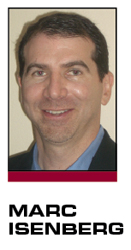Editor's note: This story is revised from the print edition.
The NCAA was founded in 1906 in response to 18 deaths that occurred in college football in the prior year. President Theodore Roosevelt told college presidents that college football must be “freed from brutality and foul play.” The message was clear: Implement corrective change or prepare for government intervention. The NCAA has been reforming itself ever since.
The latest iteration started in earnest when NCAA President Mark Emmert recently gathered 54 university presidents, chancellors and conference leaders to push forward an aggressive agenda. Said Emmert, “We have reached a point where incremental change is not sufficient. … A few new tweaks of the rules won’t get the job done.”
The NCAA has given us more than a century’s worth of mostly failed reform, so it is hard to fathom this will be any different. But college athletics appears to be coming apart at the seams. Maybe this time is for real.
There is widespread, systematic cheating in big-time college sports that cannot be reformed with more rules — or even fewer rules, which is currently being touted. Some NCAA leaders are now advancing progressive reforms that just a few years ago got me in hot water for merely suggesting. Can the NCAA’s 1,200-plus membership find commonality among the great divide?
With that in mind, here’s my blueprint for meaningful NCAA reform. My requirements are simple: I want better-educated athletes, I want them to be treated fairly and I want universities to grasp economic reality.
Put athletes in the classroom
After Emmert’s presidential retreat, the NCAA Division I board of directors voted to increase the four-year Academic Progress Rate required of teams to participate in NCAA-sponsored championships and football bowl games from 900 to 930. (The APR is an NCAA-created metric to determine academic success — or failure).
I support efforts to address the low graduation rates. The problem with tying tournament or bowl participation to the APR is that it is not coupled with activities that support actual education, such as mandates to put student athletes in the classroom. Unfortunately, these reforms have the tendency to lead to more tutoring, which too often escalates into more cheating.
If the NCAA really wants to address the problem organically, we would return to freshman ineligibility. Playing on a freshman team with limited practice time, limited travel and a relatively short season would put an emphasis on classrooms and academics.
Change amateurism
The NCAA and its members like to blame others, particularly agents, for many of the NCAA’s fundamental problems. In reality, the NCAA does not have an agent problem; it has an amateur problem. It is great that the NCAA and its members want to keep amateurs pure and free from corrupting forces, but amateur regulations, in effect, have created a booming underground economy.
If the NCAA membership is serious about reform, it must either revamp its principle of amateurism — its most fundamental and profitable principle — or live by it. What is the NCAA principle of amateurism? The “NCAA Manual” states, “Student participation in intercollegiate athletics is an avocation, and student-athletes should be protected from exploitation by professional and commercial enterprises.” Might want to add the clause, “notwithstanding the NCAA and its members.”
Since the trend line is toward more revenue, at some point the athletes who help generate billions should get something more than a scholarship, which, as many point out, is incredibly valuable. College athletes should also be allowed to get counsel from agents (but no extra benefits). And athletes should be allowed to exploit their own marketing rights.
Full cost of attendance
A full athletic scholarship is a misnomer. It does not cover the full cost of attendance, which is an additional $3,000 to $5,000 per academic year.
For the last decade, many of us have advocated increasing scholarships to close the gap. I am encouraged that many college sports leaders, including the Pac-12’s Larry Scott, the Big Ten’s Jim Delany and even Emmert, are now publicly touting an increase in athletic aid up to the full cost of attendance.
Enhancing scholarships will not eliminate cheating, but it might stop those who accept benefits out of need.
Addition by division
While some decry the “arms race” as the potential ruination of college sports, I have the opposite view. Widening the gap between the haves and have-nots can create an unintended benefit.
If the major revenue-producing schools don’t want to associate with other schools because it means giving up revenue or because they want to offer full cost of attendance scholarships, they should either disassociate or, more likely, stay in the NCAA, but form separate and unequal superconferences.
NCAA members should stop fighting the capitalist winds generated by multibillion-dollar TV contracts. BCS schools are fighting for a bigger share, which is their right. Let them. This might force non-BCS schools to take a more realistic view of college athletics by competing without the false hope of huge paydays. Best of all, BCS schools can operate as businesses, without the image problems that come from trying to be something they are not: amateur.
Setting an example
The old comic strip Pogo had a classic line that applies to college sports reform: “We have met the enemy, and he is us.” If we want to stop or curb abuse by athletes, agents and other third-party influencers, the first step is simple: Get college coaches, athletic administrators and college presidents to set an example.
Marc Isenberg (marc.isenberg@gmail.com) is the author of “Money Players: A Guide to Success in Sports, Business & Life for Current and Future Pro Athletes” and founder of moneyplayersblog.com. Follow him on Twitter @marcisenberg.




